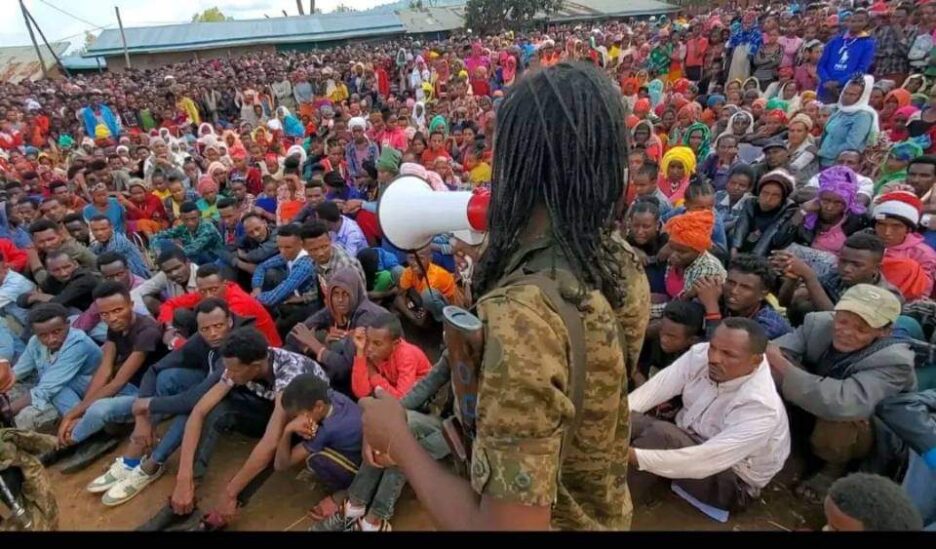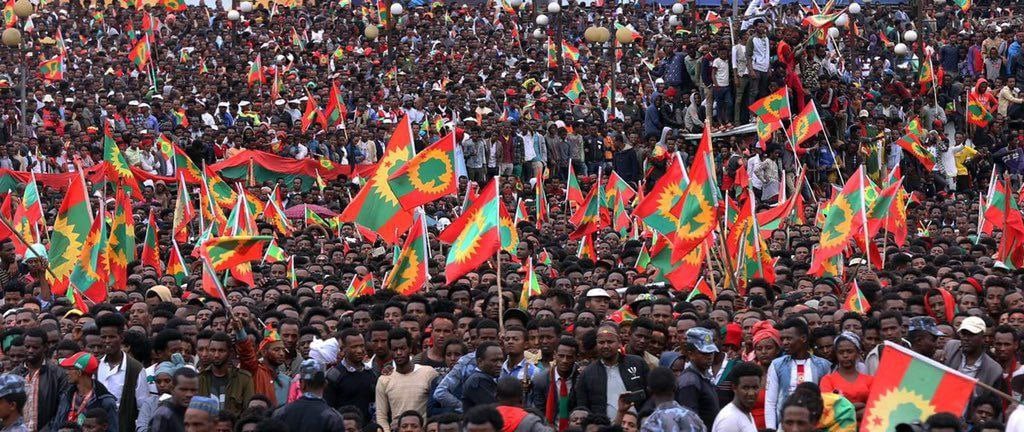|
Getting your Trinity Audio player ready...
|
If there is to be peace in the Horn of Africa, the Oromo need to be represented by those they see fit to represent them.
Every time the powers that be had to make a choice regarding a shift in Horn of Africa politics, Oromos were left, or if not completely left out, were bought out of the negotiations.
Manifestations of this were the 1990s negotiations that led to the adoption of the new constitution and the ethnic-based federal structure that governs, although not supreme, today in Ethiopia. This led to Oromos losing control of the Oromia-surrounded city of Finfinne (Addis Ababa in Amharic) and Dire Dawa, an urban center disputed between Somalis and Oromos as well as Wallo, now reduced to “Oromo Special Zone” in the Amhara region.
But a more recent example comes to mind after the relative success of the Oromo protests in 2014-2018 that weakened the grip of the Tigray People’s Liberation Front (TPLF) on power and eventually led to its departure from federal politics, ending their 27 years of control of Ethiopian politics.
The powers that be, again in consultation with everyone except the Oromo public who carried the brunt of the TPLF’s 27 years of tyrannical rule, decided that Abiy Ahmed, a half-Oromo-half Amhara, was best suited to meet the demands of the Oromo youth movement or simply Qeerroo in Afaan Oromoo. This decision, I argue, is the main factor behind the tragedies that befallen Oromia and Oromos who paid the heaviest price in the 27-year-long resistance against the TPLF regime but also Ethiopia as a country.
During the transition period, Oromo leaders who were entrusted to represent the movement appeared to be in search of power and pushed for the selection of Abiy Ahmed as a replacement for Hailemeriam Desalegn. In his in-depth article titled “How Ethiopia’s transition to democracy derailed,” Jawar Mohammed, for example, reveals that despite Lemma Megersa, then President of Oromia, being the obvious choice of protestors and activists, Abiy Ahmed was presented as an alternative. One must now ask by whom and why? Jawar says that it was the Oromo People Democratic Organization (OPDO), later Oromo Democratic Party (ODP), now Oromo Prosperity Party (OPP) and the reasoning was that Lemma was not a member of the House of People’s Representatives (HoPR).
These factors might be true, but instead of establishing a transitional government to meet one of the protest’s demands, OPDO, the Oromo opposition, and the elite decided to push for another alternative in an attempt to grab power. This move was encouraged by the West who at the time wanted to see an end to the crisis in Ethiopia.
Although the move ended the crisis, it failed to address key demands of the protestors such as the establishment of a transitional government, solving the question of Finfinne/Addis Ababa, addressing high unemployment rates in Oromia, and holding OPDO and by extension the Ethiopian People’s Revolutionary Democratic Front (EPRDF) accountable for the crimes committed during the 5 years long protests and their 27 years rule.
Ignoring these demands was bound to bring about violent conflict and the conflict soon arrived.
First, the controversial Demobilization, Disarmament, and Reintegration (DDR) process led to the breakout of hostilities between regional security forces and members of the Oromo Liberation Army (OLA) in Western Oromia. Then, an alleged assassination attempt on prominent politician Jawar Mohammed followed, which led to protests and then clashes between security forces and protestors. But the height of conflict came after the assassination of celebrated artist Hachalu Hundesa, which awakened an angry mass that saw the demands of their movements ignored and their former oppressors still oppressing them.
Post-Hachalu Ethiopia
Any observer of the Horn of Africa politics would agree that there was an Ethiopia before Hachalu’s assassination and a different Ethiopia after. Furthermore, this shows that a policy of political settlements that, intentionally or unintentionally, ignores the demands of and prosecutes the largest national group in the Horn of Africa can never be successful. Numbers matter and are often a key factor behind conflicts.
Since the inception of Ethiopia, Oromos have been the thorn to its side as resistance against assimilation and exploitation of their lands reigned supreme and still does. The Bale revolt was the first major conflict, beginning in the early 1960s and lasting until 1970. Somalia was dragged into the conflict which later resulted in the 1964 border war between the two countries, the first of a series of conflicts between the two countries that at its core had ideals of Soomaaliweyn or Greater Somalia. The revolt was suppressed but many of its leaders escaped to Somalia and rural areas of nowadays Oromia.
The failure by the Ethiopian regime (Derg) to assimilate the Oromo masses led again to conflict when former leaders from the Bale revolt sought the help of Somalia and other Muslim countries and recruited young Oromos for a second revolt. This led to the creation of the now-standing OLA in 1973 in the mountains of Hararghe, now eastern Oromia. And as a result, OLA’s Southern, Eastern, and Western divisions participated in Ethiopia’s civil war (1974-1991). Another division participated alongside Western Somali Liberation Front (WSLF) in the Ogaden war under the banner of the Somali Abo Liberation Front (SALF).
In Ethiopia, a country that refuses to change, history always repeats itself. Again the exclusion of the Oromo chosen representatives led to 27 years long armed and peaceful struggle that shook the Ethiopian entity to its foundation and resulted in the 2018 shift in power.
Abiy, like his predecessors, challenged the Oromo openly, said the Oromo youth that brought him to power are an “ungovernable pestilence that must be dealt with as soon as possible” and belittled their just demands from the onset of his premiership. Not only that but his administration also reneged on the promises made to the OLA and engaged in a war against the Oromo population. In a way, this open challenge to the movement that put him in power resulted in the deterioration of the security situation in Oromia, exhausted national resources, and emboldened other forces who are at odds with the direction Abiy Ahmed and his Prosperity Party (PP) were leading the country towards, to take matters into their own hands.
The brief history lesson is intended to paint a picture to those unfamiliar with the politics of the region as well as those who willfully chose to ignore the simple fact that without peace in Oromia, peace in the Horn of Africa is nearly impossible. It is important now because apparently the same mistake of excluding Oromos and their chosen representatives is happening again. As talks of a political solution to the conflict in Ethiopia is gathering momentum on the international stage, there seems to be a cooperative effort among stakeholders to force talks between the TPLF and the federal government, all the while ignoring the fact that Ethiopia’s civil war started in 2019, not 2020 and in Oromia, not Tigray.
It is important to remember that opposition groups in Oromia supported Abiy Ahmed’s “transition” and ignored the public’s frustration towards his policies. Grassroots support for these groups started to swindle and eventually was gone with the imprisonment of their prominent leaders in the aftermath of Hachalu Hundesa’s assassination. The regime in Finfinne and international partners’ attempts at presenting them as the only choice for the Oromo are nothing but a continuance of a long-adopted paternalistic approach to the Oromo masses.

Furthermore, it is, at this moment, a deliberate attempt to sideline the OLA whose support comes mainly from the grassroots movements that led the peaceful protests in 2014-2018. Although I doubt the intentions behind these talks are to address the root causes of recurring conflict in Ethiopia and by extension the horn; however, if returning to a state of peace in the region is important to the international community then excluding the OLA will mean the exclusion of the Oromo and in the future the resurface of conflicts.
For long-lasting peace in the Horn of Africa, the Oromo must be represented by those they see fit to represent them. The OLA despite all its faults, has grassroots support that is growing and is committed to self-determination, however shape that self-determination may take. Oromos are not after power-sharing arrangements despite the elite’s choice to stick to that narrative; rather, like any other nation in history, they are fighting for self-determination. This right to self-determination is not possible without the inclusion of OLA, and without it, peace will remain a faraway dream for Ethiopia and the region.

